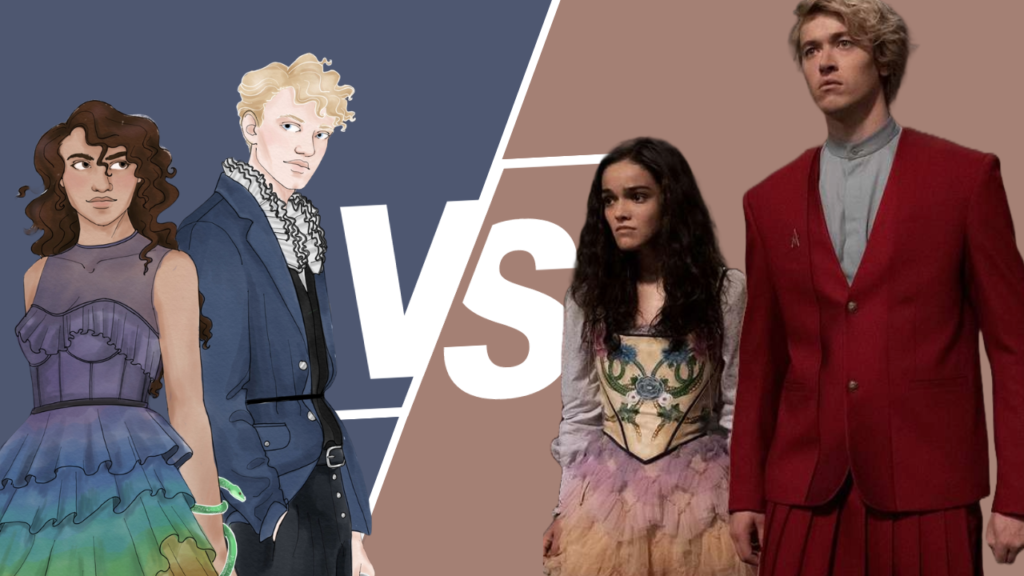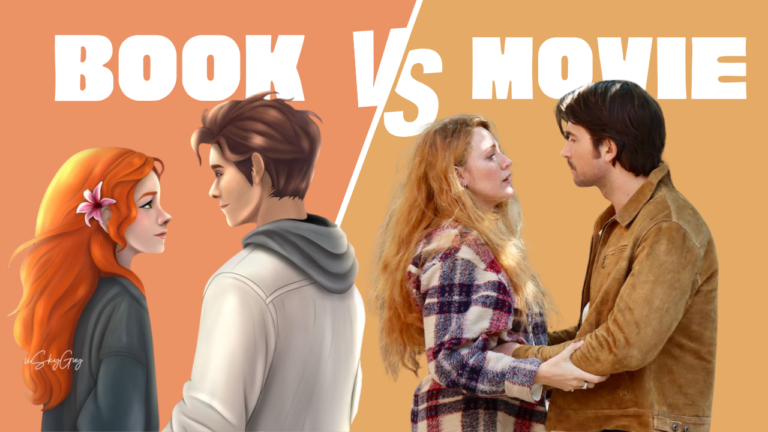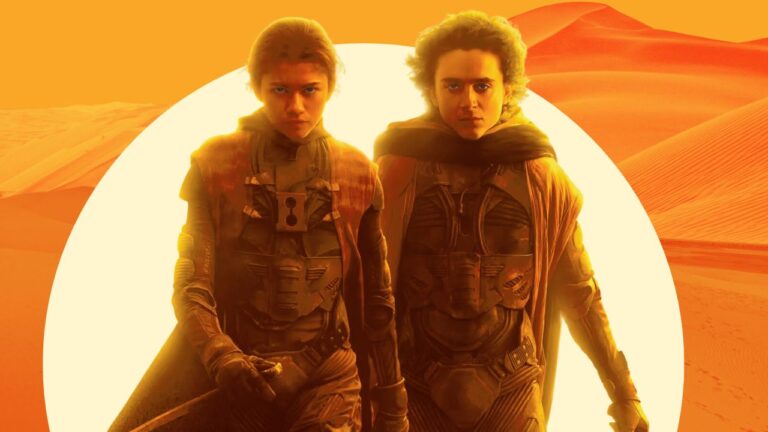Book vs Movie: The Ballad of Songbirds and Snakes

As the silver screen devours another literary masterpiece, The Ballad of Songbirds and Snakes finally slides onto our screens to complete the cinematic adaptation of Suzanne Collins’ Hunger Games universe.
This prequel to the hugely successful series of books provides a gripping tale of power, survival, and teaches us the steps to a treacherous dance of ambition.
Yet, a movie adaptation can’t help but alter and sometimes even mystify or demystify the original narrative. Some characters vanish into the inky depth of their literary roots, while others leap out and make their celluloid debut.
With that in mind, we thought it pertinent to investigate just how this adaptation lives up to the power of its source material. Just like the first four film adaptations, did the creators do Collin’s vision justice, or have they even managed to improve upon near-perfection?
Snowed in Silence
The written word is a creative realm where inner monologues and complex emotions flourish. It’s the arena where authors like Collins can explore the darkest recesses of their characters’ minds. In film, however, the screen takes charge, and subtleties often give way to action-packed visuals. This shift can leave viewers with a different emotional experience and provide new layers to the story.
At the heart of both the The Ballad of Songbirds and Snakes book and the film lies the enigmatic Coriolanus Snow. The pages of Collins’ work invite us into the labyrinth of Snow’s mind, a place where calculated machinations and latent madness collide.
In the film, however, this inner monologue is muffled, leaving us with a Coriolanus whose psychosis is less overt. Snow’s descent into darkness, a slow and deliberate waltz in the book, becomes a swifter, more enigmatic dance on screen. The absence of his internal struggles alters the perception of Snow, making him appear less overtly psychotic but equally malevolent – perhaps we even sympathize with this future villainous dictator more than if we had unfettered access to his inner deliberations and reasonings. Certainly, for those not in the know from the book or first four films, he may even represent a heroic, albeit flawed man.
After all, Coryo is a narcissist who, despite his own beliefs, engages in largely transactional relationships and quickly turns on those who no longer serve his purposes. Notably, in a departure from the source material, he tells Tigris that killing made him feel “powerful”, a very on-the-nose reference to his brewing malevolent nature waiting to emerge from the ashes of his encounters with Lucy Gray.
In the book, he is more possessive of Lucy Gray, seeing her as more of an object than a true equal and potential love interest. Though he may not have reconciled the idea, Collins perfectly hints at the fact that Lucy is just another means to an end to him until his own madness and narcissism drive him to the point of paranoia.
In the book, Lucy does not plant the seed of deceit in his mind at the cabin, he does that alone, in his thoughts while she remains entirely unaware and devoted to him. This makes his betrayal all the more poignant and hurtful to the songbird.
The film’s challenge was monumental – how do you convey the unraveling of a mind without the soliloquies that defined the character in print? The result is a Snow whose villainy is subtly nuanced, leaving audiences to ponder the depths of his depravity.
Missing Family Ties
Sejanus Plinth, a tragic figure whose familial loyalties and moral compass collide, receives nuanced treatment in Collins’s book. However, the cinematic counterpart appears as a diluted shadow of his literary self.
The familial intricacies that added layers to Sejanus’ character in the book are relegated to mere glimpses in the film, diminishing the emotional resonance that defined his narrative arc. Even his beloved Ma becomes a quick cameo, not even hinting at her love for both Sejanus and Snow.
The cinematic Sejanus, while not devoid of sympathetic undertones, lacks the emotional gravity that characterized his internal struggles in the book. The familial dynamics, a crucial element in understanding Sejanus’ choices, are subtly brushed over, transforming his character from a lead in his tragic drama to a supporting act. The film, in essence, provides a snapshot of Sejanus’ complexity, offering a taste rather than a full exploration of the character’s depth.
The omission of Corolanus’s connection to his family and ultimate assumption as heir to the Plinth fortune is also not explored as deeply. Though it is treated as an ambiguous mention near the end of the film, in the book, following Sejanus’s death, the Plinth family directs their wealth and resources to Snow, allowing him his ascension to power, the one thing he ultimately craves more than anything.
Lucy Gray a Moral Question Mark
Lucy Gray Baird, the elusive songstress of District 12, undergoes a subtle metamorphosis in her transition from the book to the cinematic adaptation. The multifaceted nature of Lucy Gray, characterized by layers of deception and survival instinct in the book, takes on a different hue on screen.
In the book, Lucy Gray’s character is a complex tapestry, leaving readers entranced by the interplay of genuine emotion and calculated strategy. The cinematic rendition, however, relies on visual cues – mischievous smiles and subtle glances – to convey the nuances of her character. This shift in emphasis, combined with the absence of certain key interactions, crafts a cinematic Lucy Gray that diverges from the intricate portrayal readers envisaged.
This makes us question her moral compass a little more, and depending on your read of her body language, she is either just as calculated as her snowy counterpart, or she is truly a naive songbird – the interplay between the two sides of Lucy Gray is not present on film.
We certainly would have loved to see more of her life with The Covey and her relationship to the people of District 12. Instead, she takes on an almost ethereally magical tone that does not do justice to her fiery character.
A Different Death March
The narrative cadence of The Ballad of Songbirds and Snakes is punctuated by poignant deaths, each carefully orchestrated to evoke specific emotional responses. The cinematic adaptation, however, engages in a subtle rearrangement. Characters such as Wovey and Dill swap causes of death between the book and film, and Reaper’s demise adopts a new rhythm, altering the emotional resonance attached to each demise.
The death shuffle, while not a seismic shift in the narrative landscape, introduces a disorienting element for those familiar with the book’s carefully choreographed emotional beats.
The essence of the story remains intact, yet the rearrangement of these critical moments serves as a testament to the delicate balance filmmakers must navigate when translating written narratives into a visual medium.
The Dilution of Dr. Gaul
Dr. Volumnia Gaul, the orchestrator of the Hunger Games macabre spectacle, assumes a more restrained persona in the cinematic adaptation compared to her literary counterpart.
In Collins’ book, Gaul embodies the quintessence of a horror movie villain, conducting twisted experiments with unbridled malevolence. However, the cinematic rendition tempers the inhumanity of Gaul’s character, applying a PG-13 filter to the horrors she orchestrates.
The metamorphosis of Dr. Gaul from literary horror to a more cautionary cinematic figure reflects the delicate line filmmakers tread between capturing the essence of the narrative and catering to the constraints of a broader audience. The PG-13 filter, while diluting the visceral impact of Gaul’s actions, serves as a testament to the inherent challenges in translating the more intense elements of written narratives to the visual medium.
Most notably, we missed out on the inhumane treatment of Clemensia Dovecote at the hands of Dr Gual.
In the film, we see her bitten by the snakes but never hear about her again, however, in the book, we are witnesses to her brutal treatment. The revelation that the snakes’ venom induces neurological damage adds a layer of complexity to the suffering endured by Clemensia. This neurological impact not only intensifies her physical pain but also disrupts her cognitive functions, leading to a profound alteration in her mental state.
Coriolanus Snow’s shared experience with Clemensia, wherein he also puts his hand into the snake tank, further complicates the narrative. The film’s omission of this detail raises questions about the selective portrayal of events and the potential impact on Coriolanus himself. The shared exposure to the snakes’ venom creates a shared trauma between them, forging a connection that is both unsettling and significant in the broader context of the story.
Clemensia’s conviction that Dr. Gaul is plotting to kill her, coupled with the growth of scales on her skin, speaks to the psychological toll inflicted by the Capitol’s experiments. The film’s decision to omit these details leaves a gap in the portrayal of Clemensia’s character arc, depriving the audience of a deeper understanding of the profound impact of Dr. Gaul’s actions on her and, by extension, on Coriolanus Snow.
The Art of Omission
Addressing the elephant in the room, the length of The Ballad of Songbirds and Snakes presented a challenge.
The book’s intricate world-building and numerous characters collided with the constraints of a single theatrical film, and even at a massive 158 minutes of run-time, the film still had to reduce numerous roles and omit some beloved scenes for the sake of brevity.
Here are some other omissions or changes the filmmakers made:
- The film makes no mention of the fact that the events of the 10th Hunger Games were erased from history. This is pertinent information for readers of the novels, as further books in the series never mention Lucy Gray Baird and Snow’s time together or the near-disastrous experiment that was the games 64 years before Katniss Everdeen became yet another symbol of rebellion and resilience from District 12.
- In the film, Sejanus is cruelly forced to listen to a recording of his plans for a rebellion, cementing the fact that he had been betrayed by Coriolanus Snow, whereas in the novel, he remains unaware of this fact until his death. This is a very smart move by the filmmakers to drive home the two-natured side of Snow and his brewing psychopathy.
- Speaking of Snow, his time as a peacekeeper is also heavily edited down from the novel. Though it forms the last third of the film, many moments differ or are missing. Though he and Sejanus meet on the train to District 12 in the movie, in the book, they meet up later, at a time when Snow’s mental decline leans toward a much darker place. Sejanus, in the books, is a savior to him at that moment, and it would have been good if that was included in the film to drive home just how devious his betrayal is.
- On a much lighter note, the role of Lucky Flickerman was expanded into host of the Hunger Games, and his charisma and minor magic tricks brought some levity to the relentless onslaught of trauma we, the viewers, and viewers in the capitol were subjected to.
As viewers, we are shown a glimpse of the dark days right at the start, ultimately creating a more sympathetic portrait of young Coriolanus, as we see him and his cousin Tigris starving and looking for food amid a deeply unnerving world where cannibalism is hinted at. This, being the opening scene, marks just how dark the film and the psyche of the main character will go.
Final Thoughts
In the grand symphony of The Ballad of Songbirds and Snakes, the differences between the book and film form a whimsical ballad of adaptation.
While some fans may find themselves hanging on to the nuances lost in translation, others may celebrate the visual spectacle and stellar performances that breathe life into Collins’ prequel.
In the delicate dance between literature and cinema, some steps are bound to be improvised. The beauty lies in the interpretation, the nuances, and the layers that each medium brings to a shared tale. As we reflect on Panem’s newest cinematic chapter, we can celebrate the convergence of the written word and the moving image, each contributing its melody to the haunting ballad of the Hunger Games.


